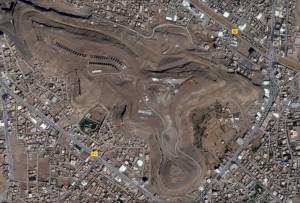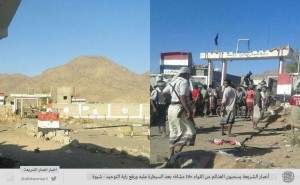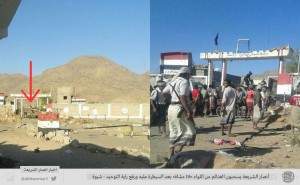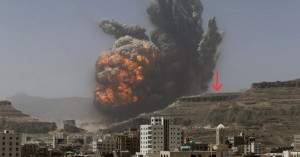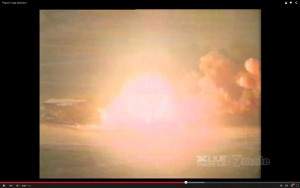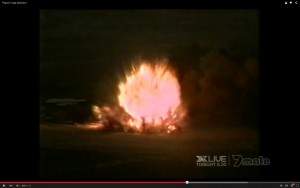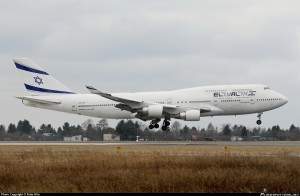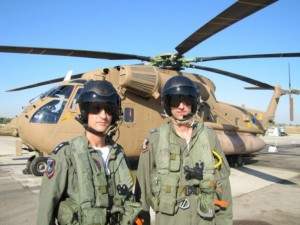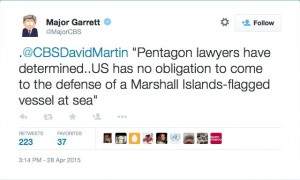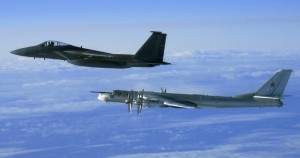The explosion in Yemen
April 29, 2024 by Thomas Wictor
On April 20, 2014, an unidentified nation dropped a gigantic bomb on a military base next to the Faj Attan neighborhood of Sana’a, the capital of Yemen. News reports said that this was a Saudi air strike that hit a SCUD missile depot. Close study of the explosion indicates that this is not true.
For one thing, it was a primary explosion, meaning the detonation of the single munition that was dropped. There were no secondary explosions. Here’s the target.
Since sound travels at 1115 feet (340 meters) per second, we can calculate the distance between the camera and the explosion.
The sound of the explosion reached the camera after seven seconds. Therefore, the man filming was one mile and 843 yards (2380 meters) away. Despite that distance, the shock wave was so powerful that the camera was jostled violently.
Several people have told me that the bomb was a regular MK-84 general-purpose 2000-lb (945 kg) munition.
That’s absolutely wrong. The MK-84 (called a GBU-31 when fitted with a JDAM guidance kit) is 10.7 feet (3.2 meters) long. You can see the shock wave dissipate quickly in this video.
These shots of Saudi GBU-31 JDAMs show the size of the explosion—the blast radius—that the munition creates.
And here’s a GBU-31 dropped in combat, only a few meters from American soldiers.
The munition used in Yemen created a shock wave that pummeled the camera and cameraman from one mile and 843 yards (2380 meters) away. This was a huge bomb.
We can also calculate the size of the explosion.
On February 12, 2015, terrorists from al-Qaeda in the Arabian Peninsula (AQAP) took over a military base in Shabwa, Yemen. After studying as many photos as I could, I’ve determined that Yemeni military bases tend to have the same kind of wall built around them.
The red arrow shows a T-72 main battle tank (MBT).
Since the T-72 is seven feet (2.1 meters) tall, the wall is about ten feet (three meters) high. The same kind of wall (red arrow) surrounds the base where the giant explosion took place.
Taking into account the fact that the underground target was far behind the wall, and the fireball and smoke tower were still expanding when this photo was taken, we can see that the explosion achieved a terminal height of well over 2000 feet (610 meters).
The blast radius of an MK-84 2000-lb bomb is 82 feet (25 meters), while the lethal fragmentation radius is 1200 feet (366 meters). This explosion in Yemen had a blast radius about fifteen times greater than that of the MK-84.
Compare the Yemen explosion to the PEPCON disaster that consumed about 4960 tons (4500 tonnes) of ammonium perchlorate (AP), an ingredient used in solid-propellant rocket boosters.
The terminal height of the biggest fireball is only about 120 feet (37 meters).
The Yemen explosion was at least an order of magnitude larger. So what dropped such a colossal bomb?
It could’ve been an Israeli 707 tanker, converted into a strategic bomber.
But today I found an article from 2009.
For the third time in the last decade, the U.S. Air Force is looking at using commercial aircraft as bombers. This time around, it’s mainly a matter of cost, with the next generation heavy bomber likely to cost over a billion dollars each, and only carry 30 tons of bombs or missiles. The idea of militarizing 747s first started gaining traction three decades ago, as cruise missiles showed up and many air force analysts did the math and realized that it would be a lot cheaper to launch these missiles from a militarized Boeing 747. The freighter version of the latest 747 model, the 747-8F, can carry 140 tons of cargo. After militarizing the aircraft, you would still be able to carry about a hundred tons of missiles and bombs.
You know who has lots of Boeing 747s in their commercial airliner fleets?
Saudi Arabia.
The United Arab Emirates.
And Israel.
To deal with enemy antiaircraft defenses, the Israeli Air Force created the Airborne Electronic Control Unit.
The objective of the Airborne Electronic Control Unit is simple: blind the enemy by disrupting its radar systems, preventing its forces from locating ours. The unit must also prevent communication between the enemy’s aircraft and control towers. To do this, the air and ground teams of the unit work closely together, helping the Air Force to achieve its ultimate goals: maintaining air superiority and defending the State of Israel…
Although they deal mostly with electronics, the soldiers also train as fighters. “This is necessary because they may be forced to eject if their aircraft is hit, and will then find themselves behind enemy lines,” [Major A.] says. “They therefore undergo not only extensive training on electronic warfare, but also learn about the enemy and its capabilities. The extent of what they need to learn is enormous.”
I wondered about this photo of Airborne Electronic Control Unit officers, since it shows a Sikorsky CH-53 Sea Stallion helicopter in the background.
But the article says the personnel may have to eject, which means they use fixed-wing aircraft. And they have ground teams of special operators inserted to help prevent bombers from being shot down. Ground troops that carry out electronic warfare in concert with aircraft? That’s a new one. I’ve been told that Israel’s electronic-warfare capabilities are at least a decade ahead of ours. My guess? Ten years is an underestimate.
Given the size of a Boeing 747, it’s possible that one aircraft could be both converted to a strategic bomber and fitted with electronic countermeasures. The only thing holding Israel back was the cost of developing massive ordnance penetrators (MOPs).
The Saudi Arabian GDP is about $750 billion.
The United Arab Emirates GDP is $402 billion.
That’s over a trillion dollars. American MOPs cost about $15 million apiece. The Saudis and Emiratis wouldn’t even feel the price of, say, ten MOPs. And I’m sure the Omanis contributed.
India and Israel are now allies. Did you know that India’s GDP is $2.3 trillion?
I know a lot of people don’t like me to write posts full of conjecture, but I can’t help it. This is fun! I could be wrong about everything, of course. So what? I’m trying to figure out what caused such an enormous explosion in Yemen. On April 28, 2015, Iran seized the container ship Maersk Tigris in international waters. This is called “piracy.” The Maersk Tigris is flagged by the Marshall Islands, a nation which in 1986 the US formally pledged to defend. Yet after their ship was boarded by Iranian Revolutionary Guard terrorists and forced into Iranian waters, this was the American response.
Under the current administration, the US has become a global laughingstock. The Iranians are hijacking our allies’ ships, and the Russians are sending Tu-95 bombers to patrol the California coastline.
But not everyone is caving. The Finns and Swedes are dropping depth charges on mystery submarines that appear in their waters. Europe is quietly sending special operators to the Ukraine. And somebody in the Middle East built a MOP and used it as a demonstration and warning.
While my country put on a red rubber nose and big yellow shoes, the world shrugged its shoulders and adapted to the new reality.
I’m glad. Just because we’ve lost our way doesn’t mean everyone else has to suffer.
This article viewed 2739 times.

